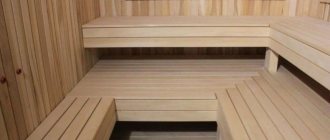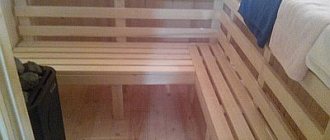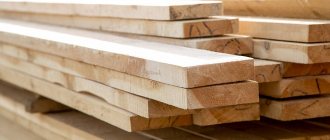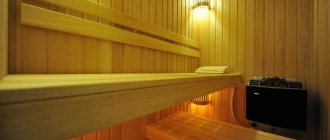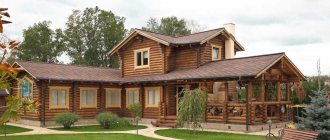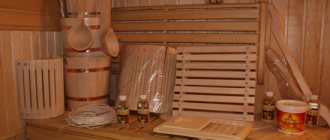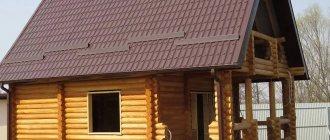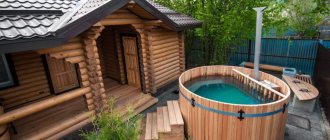Types of floors
The baths themselves are different - summer temporary huts with a pouring floor, solid all-season buildings made of wood, brick, foam blocks or frame.
But in general, we can say that the floors can be either wooden or concrete (in the steam room, provided that gratings are installed). Concrete floors are often turned into tiles in steam rooms and sinks, and they don't need painting, so we won't cover them in this article.
Wood
Wood, especially in such a humid environment as in a bathhouse, needs protection. There are several types of protection:
- impregnation;
- varnishes;
- paints.
Impregnations
These are compounds that penetrate the wood to a certain depth, performing one or another function. Some impregnations protect against mold and insects, others make the wood non-flammable or difficult to ignite, and still others make it waterproof. You can find out more about them here.
INTERESTING! Nowadays, many impregnations are made according to the “two in one” principle - it is both protection against moisture and an antiseptic. But fire retardant (from fire) must be purchased separately.
Lucky
As for varnishes, it is clear that you can use them not in all rooms, but only in conditionally “residential” ones. Although, some owners also paint the floors in the steam room and washing room with varnish.
Professionals say this: alkyd varnishes smell very long and very unpleasant, although they are inexpensive, water-based varnishes smell much less, both in strength and in time, and are much more pleasant to use.
BUT! A dispute immediately arises over imported or local products. There is an opinion that water-based varnishes are only good from Western Europe, while in the CIS and Eastern Europe they are of poor and average quality.
The price of Western European varnish “bites painfully” if the bathhouse as a whole is budget-friendly. And since few people live in the bathhouse during the period of its construction and finishing, there will be no one to be poisoned by alkyd vapors. True, the smell will completely go away only after a few months. But the price is low.
You can also paint a wooden floor in a bathhouse with “vodnik” - a water-based varnish. Remember that the addition of polyurethane gives more hardness and wear resistance to your coating. Acrylates are less resistant to wear. But again, who goes to the bathhouse a lot and constantly? So these varnishes are also suitable.
Paints
- water;
- organic solvents.
The latter smell very strongly and for a long time. Organic solvent paints include:
- enamels;
- alkyd paints;
- oil paints.
Only acrylates are soluble in water; after drying, they polymerize and no longer dissolve in water.
Acrylates are more expensive than paints based on organic solvents, but they are safer than them, have no odor that can cause poisoning, and dry quickly. But you need to paint in two layers.
For dry rooms, any type that suits your liking and pocket is suitable.
Concrete
Actually, an alternative to laying tiles could be the decision to paint the concrete floor in the bathhouse.
What does paint do? Concrete without any coating will gradually deteriorate under constant exposure to water. Of course, this is not a quick process if the cement is of high quality, but it is better not to have reasons for repairs for as long as possible.
In general, paints for concrete are quite specific; on sale you will find the following varieties:
- epoxy;
- acrylic;
- polyurethane.
ADVICE! Since we are talking about floors exposed to water, pay attention not to those varieties that are intended for industrial premises and are characterized by increased wear resistance to abrasion, but to those that, for example, are created for covering concrete pools - an excellent option for washing and steam rooms
You may be interested in more detailed material devoted to the analysis of all types of paints that can be used in a bathhouse.
How to make shelves in a bathhouse in a steam room
Anyone with basic carpentry skills can make shelves in a bathhouse with their own hands.
Drawing
To properly make shelves in a bathhouse with your own hands, start with a drawing. You need to draw up a diagram based on the dimensions of the room, taking into account the recommended sizes for benches. You need to figure out where the shelves will be located.
It is worth paying attention to the layout. It can be a multi-stage design, L or U-shaped, asymmetrical, parallel (shelves are installed on two opposite walls)
Shelves should not be located close to the walls. A gap of about 1 cm is required between the flooring and the wall to ensure air circulation in the steam room.
Frame making
When creating a frame, a wooden beam is taken. Dimensions are selected individually, but keep in mind that this will be the base of the shelves onto which the entire load will be distributed. It is best to use beams with a section of 5x7 cm.
If the project includes racks (legs), then boards will be needed. They are installed vertically, after which they are connected by transverse bridges made of timber.
Installation
The assembly of the frame begins from the top tier. Self-tapping screws are suitable for fastening.
The first row of load-bearing posts is fixed on the wall in increments of up to 80 cm. On the contrary, a second row of load-bearing posts is installed, after which their upper parts are connected by crossbars. The structure is reinforced with metal corners, after which a plank frame is made. The action is repeated in a similar way for each tier.
The frame prepared for installation is attached to the wall of the bathhouse, maintaining a ventilation gap. To give greater stability, you need to place rubber pads under the frame bars. This will also serve as additional moisture protection.
Fixation
The flooring is assembled from narrow boards so that after using the steam room the wood dries out faster.
The flooring is assembled from the lower tier, leaving gaps of 10-20 mm between the boards (necessary for condensate drainage). The boards are stuffed onto the frame using pins. Nails and self-tapping screws used for fastening are placed on the back side of the flooring or deepened into the array, otherwise their heads can subsequently severely burn the skin.
If desired, the vertical gaps between the benches can also be covered with several boards.
What is the benefit of processing
Almost all owners of personal plots who build steam rooms strive to build a room not only for washing, but for comfortable relaxation. That is why they choose natural wood as the building material for the shelves, which is ideal for a steam room. The technical characteristics of lumber make it possible to use wooden boards in rooms with extremely high air humidity, but at the same time, the service life of natural raw materials without pre-impregnation of the shelves is too short.
Since the high hygroscopicity of wood leads to the rapid absorption of moisture, the material of the shelves becomes an ideal place for the appearance of various kinds of microorganisms. The result of all these processes will be rotting of the wood. It turns black, fungus and mold appear on it. Often, the lack of impregnation leads to the accumulation of a large amount of dirt in the pores of the wood, which, in turn, provokes the appearance of parasites in it that destroy the structure of the tree.
https://www.youtube.com/watch?v=1DAmqqDffas
Today, stores have a huge number of different products that cover the shelves in the bathhouse. They are effective impregnations that not only protect natural wood from rotting, but also give it an aesthetic appearance.
Useful video
This video explains the types of impregnations and their differences:
And this video clearly demonstrates how exactly the impregnation should be applied.
Finally, let’s say that impregnations do not tolerate freezing, losing their properties, so you should buy them from trusted suppliers. Otherwise, we hope that we have been sufficiently informative, and you will easily be able to choose a coating for bath shelves.
Share on social networks
There is also oil for NORT shelves, it has shown itself to be very good in use and the price is not high. The oil contains pine essential oil. Smells nice.
Interesting. pine-scented shelves
I used a very good antiseptic for my bathhouse, which was recommended to me by my neighbors, and at one time by the seller, the name of this product was “Ultan SSA” paste. This paste helped treat and protect the regiment in the bathhouse from parasites.
I read the article and wondered if it was even worth covering the shelves in the bathhouse with something if it was possible to periodically replace them as they wear out. Still, I decided it was worth it. I am especially concerned about this issue in terms of antiseptics. Does anyone know if essential oils with antiseptic properties like eucalyptus or tea tree can be used for treatment? Will there be an effect?
Vika, if the funds allow you to replace the shelves, then you don’t have to worry at all
